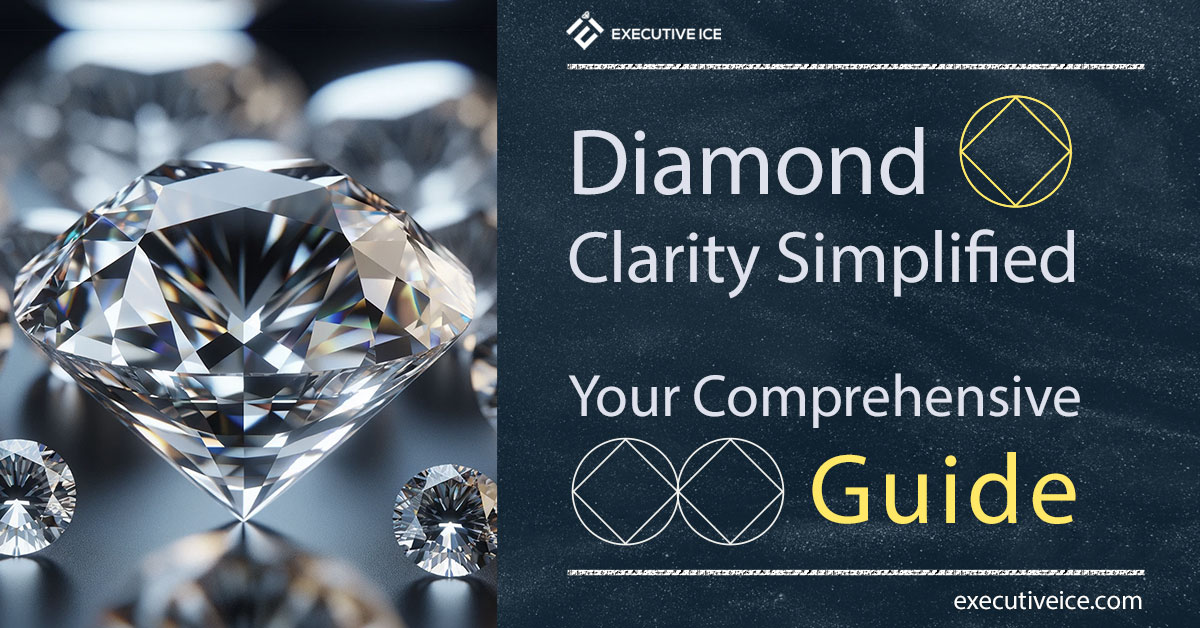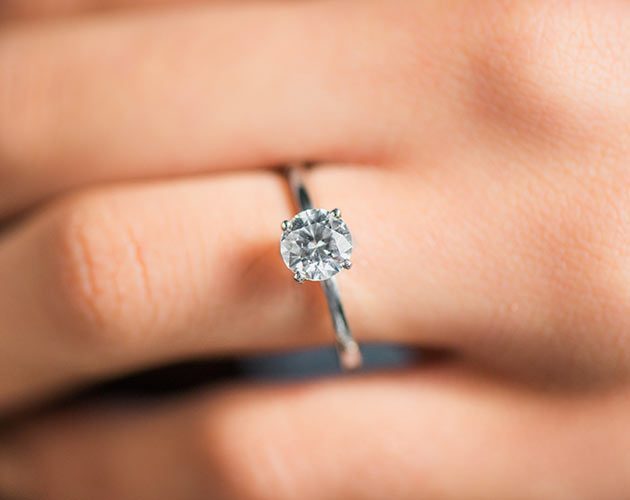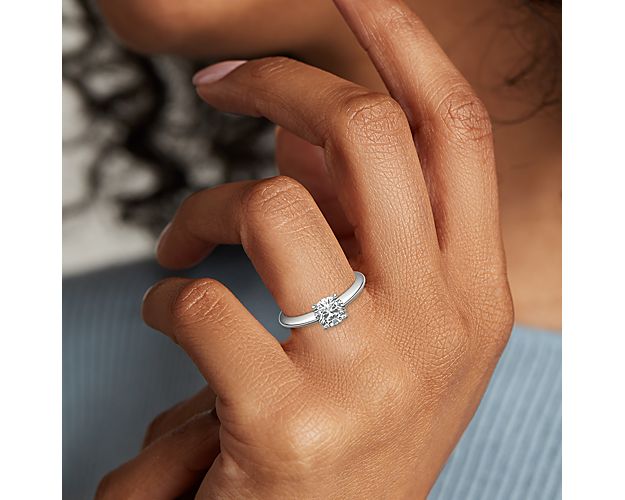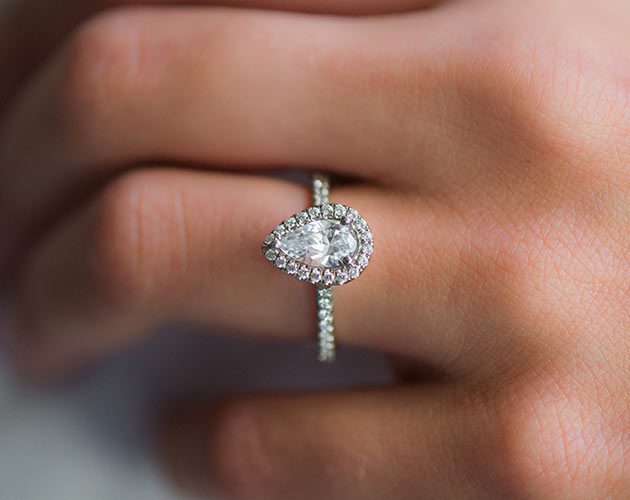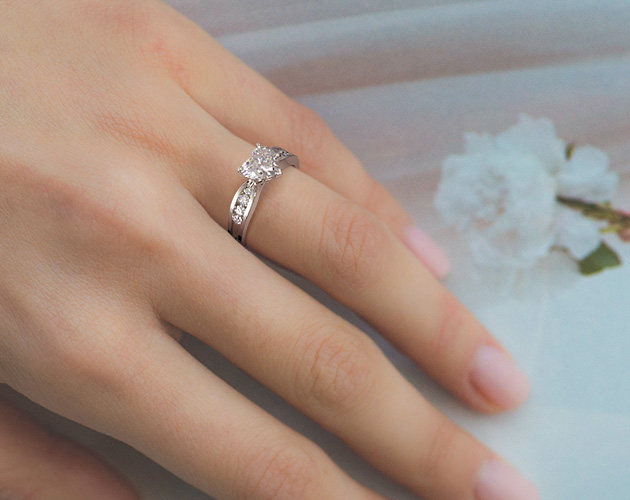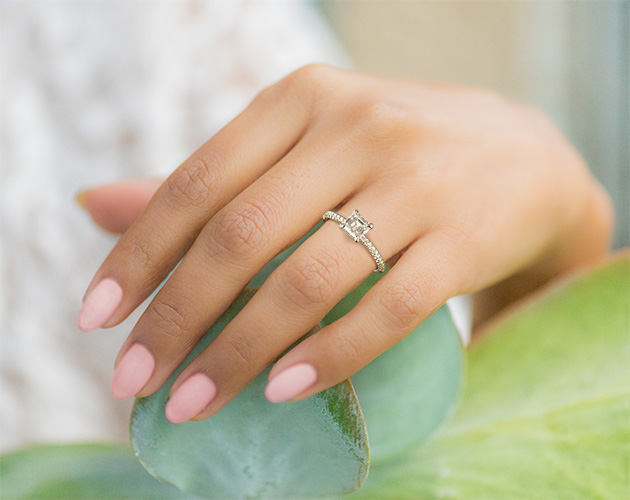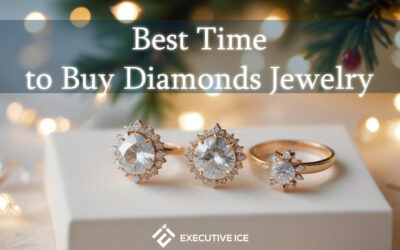Embarking on our journey through the world of diamonds, we ask, ‘What is diamond clarity?’ Let’s begin by exploring its role and significance in the overall valuation of these precious stones.
1. Introduction
-
Overview of diamond clarity and its significance in diamond valuation
Today we’re going to talk about something really important in the diamond world – diamond clarity. Clarity is one of those things that can make a big difference in how much a diamond is worth, just like the clearness of a mountain stream can tell you a lot about its health.
In simple terms, diamond clarity refers to how clear or ‘clean’ the diamond is. This means looking at any tiny natural imperfections inside the stone, which we call inclusions, or on its surface, known as blemishes. Just like in nature, where no two leaves are exactly the same, each diamond has its own unique set of these characteristics.
Now, why does clarity matter so much? Well, it’s all about the sparkle and the light. The clearer a diamond is, the more it can let light dance through it, making it sparkle and shine like the stars at night. Diamonds with high clarity are rarer, and as you might guess, they’re often more valuable.
But here’s an interesting thing – many of these inclusions and blemishes are so tiny, you can’t even see them without a magnifying glass or a microscope. So, while clarity is important, it’s just one part of what makes each diamond special.
As we go further into this guide, we’ll dive deeper into what diamond clarity really means, how it’s measured, and how you can choose the right clarity for your own special diamond. It’s a journey into the heart of these beautiful stones, understanding what makes each one unique and precious in its own way.
2. Understanding Diamond Clarity
-
Explanation of What Diamond Clarity Means
When we talk about the clarity of a diamond, we’re focusing on the natural marks that are like the story of its journey from deep within the Earth. Clarity is all about the little imperfections, known as inclusions and blemishes. Inclusions are those tiny internal marks, kind of like the knots in the wood, while blemishes are small surface flaws, like the ripples on a pond.
These imperfections are formed when the diamond is created under high-pressure deep underground. Most times, they’re so small that you can’t see them without a magnifier. It’s a bit like looking at the tiny details in a leaf or a stone – you often need to look really close to see them.
Now, why do these tiny marks matter? Well, they can affect how light travels through the diamond, impacting its sparkle and brilliance. A diamond with fewer and smaller inclusions usually lets more light pass through, making it shine brighter. But remember, every diamond’s clarity is unique, which adds to its special character.
So, when we’re judging a diamond’s clarity, we’re not just looking for ‘flaws.’ We’re reading the story of its formation, a tale that’s as old as time, locked within this sparkling gem. Each inclusion and blemish has a tale to tell, adding to the diamond’s unique beauty and value.
-
The diamond clarity scale: Understanding the different grades.
The diamond clarity scale is like a map that helps us navigate through the different levels of how clear or included a diamond is. Created by gemologists, this scale classifies diamonds based on the presence and visibility of inclusions and blemishes.
When determining a diamond’s clarity grade, the Gemological Institute of America (GIA) meticulously evaluates several factors. These include the size, nature, position, color, and quantity of inclusions, as observed under 10× magnification, which are typically not visible to the naked eye.
The criteria employed by GIA are exceptionally stringent, solidifying its reputation as a premier certification laboratory.
To provide a clearer picture, here’s an illustration of the diamond clarity chart:

Additionally, here is another image to enhance your understanding further:
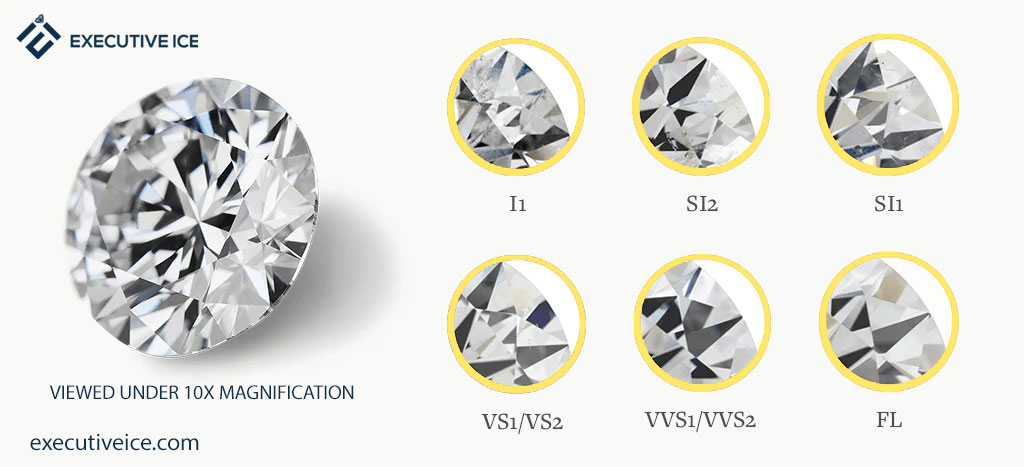
-
Flawless (FL) and Internally Flawless (IF):
These are the rarities, diamonds so clear they’re like pure mountain air. FL diamonds have no inclusions or blemishes visible under 10x magnification, while IF diamonds have no inclusions and only insignificant blemishes.
Discover the exceptional beauty of FL-IF clarity diamonds at James Allen
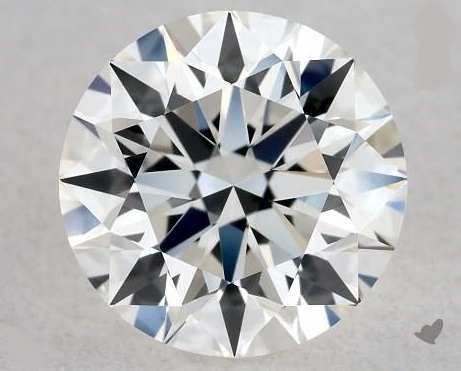
Source image: James Allen
-
Very, Very Slightly Included (VVS1 and VVS2):
These diamonds have inclusions so small that they’re difficult for even a skilled grader to see under 10x magnification. It’s like spotting a tiny bird far off in the sky.
Browse Blue Nile’s elegant range of VVS1 and VVS2 clarity diamonds
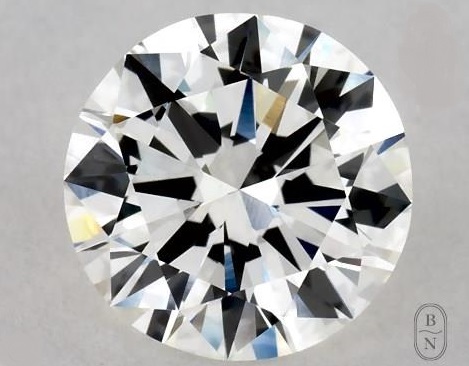
Source image: Blue Nile
-
Very Slightly Included (VS1 and VS2):
Inclusions in these diamonds are only seen with effort under 10x magnification. It’s like noticing small ripples on a distant lake.
Check out VS1/VS2 Clarity diamonds on Whiteflash.
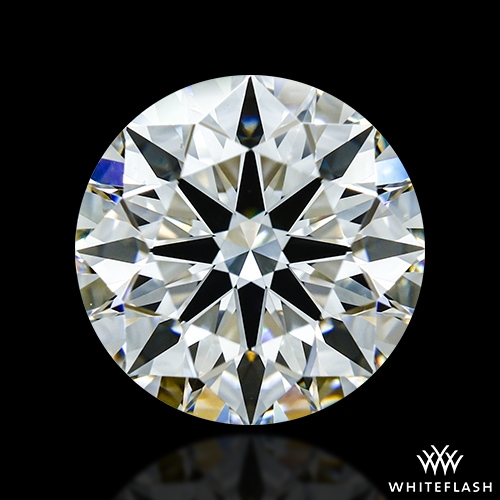
Source image: WhiteFlash
-
Slightly Included (SI1 and SI2):
These diamonds have inclusions that are more easily spotted under magnification. They’re like leaves with more noticeable veins.
Explore SI1 diamonds on James Allen here.
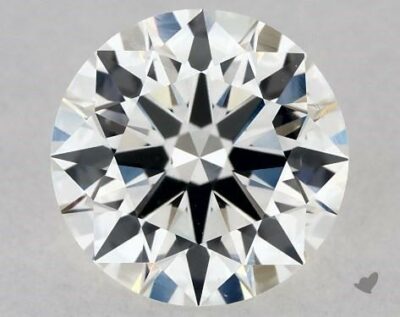
Source image: James Allen
-
Included (I1, I2, and I3):
Inclusions in these diamonds are obvious under magnification and may affect transparency and brilliance. They’re akin to knots and splits in wood, clearly visible and part of the character.
Remember, each grade tells us something about the diamond’s journey from deep within the Earth. While higher clarity grades are more valuable, many inclusions are not visible to the naked eye, making lower-grade diamonds still incredibly beautiful and often more affordable. It’s about finding the diamond that speaks to your heart, with a clarity grade that suits your eye and your budget.
3. Factors Determining Clarity
-
Types of inclusions and blemishes that affect clarity
When we look at a diamond’s clarity, we’re essentially examining its natural characteristics – the inclusions and blemishes that tell the story of its creation.
-
Inclusions:
These are internal features, much like the marks you might find in a piece of ancient wood or inside a stone pulled from the river.
-
-
Clouds: These are clusters of tiny inclusions that can appear hazy, like a small cloud inside the diamond.
-
Feathers: These are small fractures or cracks within the diamond, looking a bit like a feather’s delicate lines.
-
Crystals or Minerals: Sometimes, as a diamond forms, other minerals get trapped inside. These can look like tiny crystals or specks.
-
-
Blemishes:
These are external marks on the diamond’s surface, akin to the scrapes and nicks on a well-used hiking stick.
-
-
Scratches: Fine lines on the surface of the diamond, usually caused by wear and tear.
-
Pits: Small dents or spots, like tiny indentations in a rock.
-
Chips: Small pieces broken off, often occurring at the diamond’s edges or points.
-
For a clearer visual understanding, take a look at these images:


Each of these inclusions and blemishes contributes to a diamond’s unique appearance and tells a part of its history. They can affect how light moves through the stone, influencing its overall sparkle and appeal. However, many of these features are only visible under magnification, so to the naked eye, the diamond can still appear flawless and radiant.
In the world of diamonds, clarity is about embracing these natural characteristics, each adding to the gem’s unique beauty. It’s a reminder that perfection comes in many forms, each with its own story and charm.
-
How clarity is assessed and graded in laboratories
When it comes to figuring out a diamond’s clarity grade, it’s a bit like a skilled craftsman examining a precious artifact, looking closely at every little detail.
In laboratories, gemologists use specific tools and methods to assess clarity:
-
Magnification:
First, they examine the diamond under 10x magnification. This is like using a magnifying glass to look at the intricate patterns on a leaf. It helps them see the inclusions and blemishes that are too small to be noticed with the naked eye.
-
Lighting and Background:
They use proper lighting and a neutral background. This is important because different lighting and colors can make inclusions more or less visible. It’s like how the details of a landscape change with the daylight.
-
Expert Eye:
The gemologists then identify and map the inclusions and blemishes. They’re looking for their size, number, position, color, and nature. It’s a bit like a botanist cataloging the features of different plants.
-
Clarity Grade Assignment:
Based on these observations, the diamond is assigned a clarity grade. This grade follows a standard scale, like the one we talked about earlier, ranging from Flawless to Included.
-
Consistency in Grading:
To ensure accuracy and consistency, often more than one expert will grade the diamond. It’s like getting a second opinion to make sure the assessment is spot-on.
So, when a diamond’s clarity is graded, it’s not just a quick glance. It’s a thorough and careful examination, ensuring that each diamond’s unique features are accurately identified and recorded. This careful assessment is what helps determine how clear the diamond is and, in turn, part of what makes each diamond special.
4. Clarity and Diamond Appearance
-
The Impact of Clarity on a Diamond’s Appearance
Understanding how clarity affects a diamond’s look is like appreciating how clear waters in a lake can enhance its beauty.
-
Brilliance and Sparkle:
Clarity plays a big role in a diamond’s ability to sparkle and shine. A diamond with fewer and smaller inclusions allows more light to pass through, enhancing its natural brilliance. It’s akin to sunlight streaming through a clear stream, lighting it up with sparkles.
-
Visibility of Inclusions:
While many inclusions and blemishes are too small to be seen by the naked eye, larger or more numerous ones can affect the diamond’s appearance. They can interrupt the path of light within the diamond, affecting its sparkle. It’s similar to how a few pebbles in a stream might not disrupt the flow, but larger rocks can change the water’s course.
-
Overall Aesthetics:
Diamonds with higher clarity grades often have a more pristine and refined appearance. However, even diamonds with lower clarity grades can possess a unique beauty, with inclusions that add character. It’s like finding beauty in the natural patterns of tree bark or the ripples in sand.
-
Personal Preference:
Some people may prefer the flawless look of a high-clarity diamond, while others may appreciate the unique features of inclusions. It’s a matter of personal taste, much like how some prefer the calm of a still pond, while others find beauty in the lively ripples of a river.
In essence, clarity is a key factor that contributes to a diamond’s overall appearance. It’s important to consider how clarity aligns with your preferences for brilliance and aesthetics. Just as nature’s beauty comes in many forms, so does the beauty of each diamond, influenced in part by its clarity.
5. Choosing the Right Clarity for Your Diamond
-
How to balance clarity with other diamond characteristics (cut, color, carat)
When it’s time to choose your diamond, think of it like weaving a beautiful tapestry. It’s not just about one thread, but how they all come together.
-
Clarity and Cut:
The cut of the diamond can enhance or diminish its clarity. A well-cut diamond can make some inclusions less visible, maximizing its sparkle and making the most of its clarity. It’s like how the right lighting can make a painting’s colors more vibrant.
Expand your understanding of cut with our thorough beginner’s guide to diamond cut.
-
Clarity and Color:
These two aspects go hand in hand. Sometimes, a diamond with a lower clarity but a better color can appear more beautiful than one with higher clarity but a poorer color. It’s like finding the right balance between the light and shadow in a photograph.
Deepen your knowledge of color with our extensive guide to diamond color.
-
Clarity and Carat:
The larger the diamond, the more noticeable inclusions may become. If you’re leaning towards a larger carat, you might want to consider a higher clarity grade. It’s like choosing a bigger canvas for a painting; you want to ensure the details are just right.
Gain a deeper understanding of carat through our detailed guide to diamond carat.
-
Overall Appearance:
Remember, a diamond should be pleasing to your eye. Sometimes, diamonds with minor inclusions can still be stunning. It’s about how all these characteristics harmonize to create something beautiful.
-
Budget Considerations:
Often, clarity is a place where you can adjust to fit your budget. By compromising slightly on clarity, you may be able to choose a larger carat or a better color. It’s about finding the right balance that works for you financially and aesthetically.
Selecting the right clarity for your diamond is about understanding how it interacts with cut, color, and carat. It’s about seeing the bigger picture and how each aspect contributes to the overall beauty of the diamond. Just like in nature, it’s the combination of elements that creates something truly breathtaking.
-
Tips for selecting the best clarity grade within your budget
Picking the right clarity grade for your diamond is a bit like choosing the best fishing spot on the river; it’s about knowing where to look and what to prioritize.
-
Understand the Scale:
Familiarize yourself with the clarity scale. Remember, higher grades like Flawless or Internally Flawless are rare and pricey. Often, diamonds in the Very Slightly Included or Slightly Included categories offer a good balance of clarity and value.
-
Use Your Eyes:
See the diamonds in person, if possible, or look at high-quality photos and videos. Sometimes, the differences in clarity grades aren’t visible to the naked eye, especially in the VS (Very Slightly Included) to SI (Slightly Included) range. Trust what looks good to your eye.
-
Consider Diamond Size:
In larger diamonds, inclusions are more visible. If you’re opting for a larger stone, you might want to go a bit higher on the clarity scale. For smaller diamonds, you can often choose a lower clarity without affecting the appearance.
-
Balance with Other Factors:
Weigh clarity against other characteristics like cut and color. A well-cut diamond of a lower clarity grade can still be stunningly brilliant. Sometimes, compromising slightly on clarity allows you to invest more in a better cut or color.
-
Seek Expert Advice:
Talk to a trusted jeweler who can guide you through the selection process. They can help you find a diamond that fits your budget without compromising on beauty.
-
Remember the Setting:
The ring’s setting can sometimes mask certain inclusions, so consider how the diamond will be mounted. Some settings can hide small imperfections, allowing you to choose a lower clarity grade without it being noticeable.
In the end, the best clarity grade is one that satisfies both your eyes and your budget. It’s about finding that sweet spot where the diamond’s natural beauty shines through without stretching your finances. Like choosing the right path in the woods, it’s about finding the one that offers beauty and value in harmony.
6. Clarity and Diamond Shapes
-
How Different Diamond Shapes Interact with Clarity
Different diamond shapes can reveal or conceal clarity characteristics in their own special ways, much like how sunlight plays differently on the waters of various rivers and lakes.
-
Round Brilliant Cut:
This classic shape is quite forgiving when it comes to clarity. Its brilliant cut pattern, designed for maximum sparkle, can often mask small inclusions, allowing for a bit more leeway in clarity without affecting the diamond’s appearance.
Experience the elegance of this 1.00 carat, H color, VS1 clarity, very good cut round diamond from James Allen, a true embodiment of sophistication and brilliance👇
-
Emerald and Asscher Cuts:
With their large, open tables and step-cut facets, these shapes can make inclusions more visible. It’s like looking through clear, still water; everything beneath the surface is more noticeable. For these shapes, a higher clarity grade might be worth considering.
Here👇 for example, is the refined elegance of Blue Nile’s 1.00 carat, G color, VVS2 clarity, emerald cut diamond, a masterpiece of exquisite craftsmanship and luminous beauty.
-
Oval, Pear, and Marquise Cuts:
These fancy shapes can also hide certain inclusions due to their brilliant cut facets. However, because of their elongated form, they might highlight inclusions near the edges or the ‘points’ of the diamond.
Behold the graceful allure of this SI1 clarity pear-shaped diamond from James Allen, radiating a unique and captivating elegance👇
-
Princess Cut:
This popular square shape, with its intricate faceting, can be quite effective at hiding small inclusions, much like the round cut. It allows for a bit of flexibility in choosing clarity.
Here’s a look at that from WhiteFlash👇
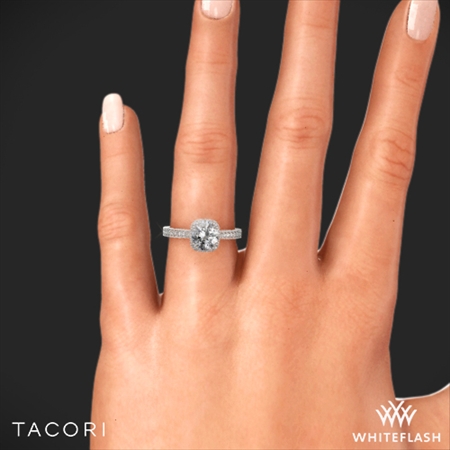
-
Heart Shape:
The unique shape of a heart-cut diamond can draw attention away from minor inclusions, especially around the curved parts of the heart.
Here’s a glamorous look for VS2 Clarity Heart Shaped Diamond👇
When choosing a diamond, consider how its shape and clarity interact. Some shapes are more accommodating of lower clarity grades, while others might require a closer look to ensure the inclusions don’t detract from the stone’s beauty. It’s like choosing the right vessel for your journey; you want one that will navigate smoothly and show its best along the way.
7. Clarity Myths and Misconceptions
-
Addressing common myths and misconceptions about diamond clarity
When it comes to diamond clarity, there are a few tales and misunderstandings that can lead us astray, much like old folklore might. Let’s set these straight.
-
Myth—> Higher Clarity Equals More Sparkle:
Many believe that the higher the clarity, the more a diamond will sparkle. While clarity does impact a diamond’s appearance, it’s the cut that primarily determines its brilliance and sparkle. A diamond with a lower clarity but excellent cut can still be dazzling.
-
Misconception—> All Inclusions Are Bad:
Inclusions are often seen as flaws, but they can actually add character to a diamond without significantly impacting its beauty. Many inclusions are microscopic and don’t detract from the diamond’s appearance to the naked eye.
-
Myth—> You Need a Flawless Diamond:
While flawless diamonds are coveted, they are extremely rare and expensive. In reality, most diamonds used in jewelry have some inclusions, and many are still stunning and desirable.
-
Misconception—> Clarity Is the Most Important Factor:
While clarity is important, it’s just one of the 4Cs (cut, color, clarity, carat). It should be considered in balance with the other characteristics, not as the sole deciding factor.
-
Myth—> Inclusions Always Make Diamonds Weak:
It’s thought that inclusions can make a diamond more prone to damage. While this can be true for certain types of inclusions, most do not significantly affect a diamond’s structural integrity.
Understanding the reality behind these myths and misconceptions can help you make a more informed decision. It’s about looking at the diamond as a whole – its story, its journey from deep within the Earth, and how all its characteristics come together to create something unique and beautiful. Just like in nature, each diamond, with its clarity and inclusions, is a piece of art to be appreciated.
8. Caring for Your Diamond
-
Maintenance tips to preserve the clarity of your diamond over time
Taking care of a diamond is like looking after something precious from Mother Earth. Here are some tips to keep your diamond as clear and sparkling as the day you got it:
-
Regular Cleaning:
Just like the windows in your home, diamonds need regular cleaning to keep their brilliance. Use a soft brush, warm water, and a bit of gentle soap to carefully clean them. This will remove any oils or residues that can cloud the diamond’s appearance.
-
Avoid Harsh Chemicals:
When doing household chores or getting ready with cosmetics, remember to protect your diamond. Harsh chemicals can dull its sparkle. It’s like protecting a delicate flower from strong winds.
-
Professional Check-ups:
Just as you would visit a healer for wellness, take your diamond to a jeweler for regular check-ups. They can professionally clean it and check for any loose settings or potential damage that might affect its clarity.
-
Safe Storage:
When you’re not wearing your diamond, store it in a fabric-lined jewelry box or a soft pouch. Diamonds can scratch other jewelry and even each other. It’s like giving a bird a safe nest to rest in.
-
Gentle Handling:
Be mindful of how you handle your diamond. Although they are one of the hardest substances on Earth, a hard blow can still damage them, especially around the edges. It’s like handling a beautiful but delicate pottery piece.
By following these simple tips, you’ll help ensure that your diamond stays as beautiful and clear as the day it was crafted. It’s about giving it the care and respect it deserves, so it can continue to bring that unique sparkle to your life.
9. FAQs About Diamond Clarity
-
Addressing common questions
Here we go, diving into some of the most common questions about diamond clarity.
-
What is diamond clarity?
Diamond clarity refers to the absence or presence of inclusions and blemishes within or on the surface of a diamond. Inclusions are internal characteristics like tiny crystals, feathers, or clouds, while blemishes include scratches or pits on the diamond’s surface.
The clarity of a diamond is one of the key aspects (alongside cut, color, and carat) that determine its overall appearance and value. It is assessed using a standardized clarity scale, which ranges from Flawless (no inclusions or blemishes visible under 10x magnification) to Included (inclusions and/or blemishes are obvious under 10x magnification and may affect transparency and brilliance). The higher the clarity grade, the fewer the imperfections, and the clearer and more valuable the diamond typically is.
-
What is the best clarity for a diamond?
The “best” clarity for a diamond largely depends on individual preferences and what you value most in a diamond. From a gemological perspective, the highest clarity grade is ‘Flawless’ (FL), which means there are no inclusions or blemishes visible under 10x magnification. However, diamonds of this clarity grade are extremely rare and expensive.
For most practical purposes, diamonds in the ‘Very Slightly Included’ (VS) or ‘Slightly Included’ (SI) ranges are often considered excellent choices. They offer a good balance between visual appeal and cost. In these grades, inclusions are typically not visible to the naked eye, making them ideal for those who want a beautiful diamond without the premium price of higher clarity grades.
Ultimately, the best clarity grade is one that meets your personal criteria for beauty and value, and fits within your budget.
-
Is VS1 or VS2 better?
In the diamond clarity grading system, VS1 and VS2 are two grades within the ‘Very Slightly Included’ category. Between the two, VS1 is considered a higher clarity grade compared to VS2.
VS1: This grade means that inclusions are very slightly included, making them difficult to see under 10x magnification. The inclusions in VS1 diamonds are typically smaller or less visible than those in VS2 diamonds. They are often located in less conspicuous places where they are less likely to affect the diamond’s overall appearance.
VS2: Diamonds graded as VS2 have inclusions that are also classified as very slightly included but are typically larger or more apparent under magnification than those in VS1 diamonds. However, these inclusions are usually still invisible or hard to see with the naked eye.
While VS1 is technically a better grade due to its fewer and smaller inclusions, the difference may not always be noticeable to the naked eye, especially in smaller diamonds. The choice between VS1 and VS2 often comes down to personal preference, the specific characteristics of the individual diamond, and budget considerations. In many cases, VS2 diamonds offer a good balance of beauty and value, making them a popular choice for those looking to maximize their budget without compromising significantly on clarity.
-
Is 12 diamond clarity good?
An I2 diamond clarity is considered to be on the lower end of the diamond clarity grading scale. In the context of this scale, “I2” stands for “Included 2,” indicating that the diamond contains noticeable inclusions which are quite obvious under 10x magnification and often visible to the naked eye.
Appearance:
Inclusions in an I2 clarity diamond can affect its overall appearance, potentially impacting its brilliance and transparency. These inclusions can be large or numerous enough to detract from the stone’s natural beauty.
Affordability:
While I2 clarity diamonds are among the more affordable options due to their lower grade, the trade-off is in the aesthetic quality of the diamond. For those on a tight budget, an I2 clarity diamond can be a viable option.
Suitability:
Whether an I2 clarity diamond is “good” depends on individual preferences and the intended use of the diamond. For those who prioritize clarity and a flawless appearance, I2 diamonds may not be the ideal choice. However, for buyers who are more concerned with size or cost than with perfect clarity, an I2 diamond might be suitable.
In summary, I2 diamond clarity is not typically sought after for high-end jewelry due to the noticeable inclusions. However, it may be considered “good” in scenarios where clarity is less of a priority compared to other factors such as price or carat weight.
-
What is the lowest grade diamond?
The lowest grade in the standard diamond clarity grading system is “I3,” which stands for “Included 3.” In this clarity grade, diamonds have inclusions that are very obvious under 10x magnification and usually visible to the naked eye. These inclusions can be such that they affect the stone’s transparency, brilliance, and overall structural integrity.
In the I3 clarity grade, the inclusions are not just noticeable; they are prominent and often impact the diamond’s appearance significantly. This grade is at the lower end of the clarity scale, which also includes (from highest to lowest) Flawless (FL), Internally Flawless (IF), Very Very Slightly Included (VVS1 and VVS2), Very Slightly Included (VS1 and VS2), Slightly Included (SI1 and SI2), and Included (I1 and I2).
Diamonds with an I3 clarity are typically the most affordable due to these visible inclusions, but they lack the aesthetic appeal of higher-grade diamonds. These diamonds are often used in applications where clarity is less of a concern or in jewelry pieces where the diamond’s clarity is not the central focus.
-
Which clarity diamond is most expensive?
The most expensive diamonds in terms of clarity are those that fall within the ‘Flawless’ (FL) and ‘Internally Flawless’ (IF) categories. These clarity grades represent the peak of the clarity grading scale.
Flawless (FL):
A Flawless diamond has no inclusions or blemishes visible under 10x magnification. It’s considered the epitome of purity and rarity in the diamond world, making it highly desirable and, consequently, very expensive.
Internally Flawless (IF):
Diamonds graded as Internally Flawless have no inclusions and only insignificant surface blemishes visible under 10x magnification. They are almost as rare and valuable as Flawless diamonds, commanding very high prices.
The rarity of FL and IF diamonds contributes significantly to their high cost. They represent a very small fraction of all diamonds mined, making them highly sought after by collectors and connoisseurs who are willing to pay a premium for their exceptional clarity.
It’s important to note that while FL and IF diamonds are the most expensive in terms of clarity, the overall price of a diamond is also influenced by its other characteristics, such as cut, color, and carat weight, as per the 4Cs of diamond quality.
-
Is clarity important in a diamond?
Clarity is indeed an important aspect to consider when evaluating a diamond, as it is one of the key attributes in the 4Cs of diamond quality (cut, color, clarity, and carat weight).
Impact on Appearance:
Clarity refers to the presence of internal inclusions and surface blemishes in a diamond. These imperfections can affect how light is reflected and refracted within the diamond, influencing its sparkle and overall brilliance. A diamond with higher clarity will typically have fewer visible flaws, allowing more light to pass through and create more sparkle.
Aesthetic Value:
Many people desire diamonds with fewer visible inclusions because they tend to look clearer and more aesthetically pleasing. Diamonds with higher clarity grades are often more sought after for their pristine appearance.
Personal Preference and Budget:
However, the importance of clarity can vary based on personal preference and budget. Some buyers may prioritize a higher carat weight or a specific cut over clarity, especially if the inclusions are not easily visible to the naked eye. Diamonds with lower clarity grades can still be beautiful and are often more affordable.
Overall Balance:
It’s important to balance clarity with the diamond’s other characteristics. For instance, a diamond with excellent cut and color but slightly lower clarity can still be a stunning choice.
In conclusion, while clarity is a crucial factor in a diamond’s quality and appearance, its importance relative to other factors depends on individual preferences, intended use, and budget. For many, a balance of all the 4Cs leads to the best choice in selecting a diamond.
-
Should I buy an I2 diamond?
Whether to buy an I2 clarity diamond depends on your individual preferences, needs, and budget.
Understanding I2 Clarity:
An I2 (Included 2) diamond has noticeable inclusions visible under 10x magnification, which are often also visible to the naked eye. These inclusions can affect the diamond’s brilliance and overall appearance.
Consider Budget and Preferences:
If you are working with a limited budget and size is a priority, an I2 clarity diamond might offer a larger size at a lower price. However, be prepared for visible imperfections.
Assess Appearance:
Evaluate if the inclusions in the specific I2 diamond you’re considering are acceptable to you in terms of visibility and how they affect the stone’s overall look. Some I2 diamonds may have inclusions that are less noticeable, while others have more prominent flaws.
Intended Use:
For certain types of jewelry or settings where clarity is less noticeable or not a top priority, an I2 clarity diamond might be suitable.
Seek Professional Advice:
It’s a good idea to seek guidance from a trusted jeweler. They can provide detailed information about the diamond’s inclusions and how they impact its appearance and durability.
Consider Other Factors:
Remember to balance clarity with other aspects of the diamond, like cut, color, and carat weight. Sometimes a smaller diamond with a higher clarity grade can be more appealing than a larger I2 diamond.
In summary, purchasing an I2 clarity diamond is a personal decision. If you prioritize size and price over clarity and are comfortable with visible inclusions, an I2 diamond could be an option. However, if clarity and overall appearance are important to you, exploring higher clarity grades might be more satisfying.
-
What is the lowest diamond clarity that looks good?
The lowest diamond clarity grade that still looks good often varies based on individual perception, but generally, diamonds in the ‘Slightly Included’ (SI) range are considered to strike a good balance between visible imperfections and aesthetic appeal.
In the photo below, for example, You can check SI1 Clarity Asscher Diamond – 1.00 Carat – H Color
In summary, while diamonds in the SI clarity range are generally considered the lowest grade that maintains a good appearance, the decision will ultimately depend on your personal standards and preferences. Many find that SI clarity diamonds offer a good compromise between quality and cost, providing an attractive appearance without the higher price tag of more flawless stones.
10. Conclusion
-
Summarizing Key Points About Diamond Clarity
Diamond clarity is a beautiful and complex aspect of these precious stones, like the intricate patterns in nature. It’s about the inclusions and blemishes that each diamond holds, telling a story of its journey from deep within the Earth.
Clarity is Unique: Every diamond is unique in its clarity, with a range of grades from Flawless to Included. Remember, these natural characteristics, while often microscopic, play a big role in the diamond’s overall beauty and value.
Balance is Key: Clarity is just one part of a diamond’s story. It’s important to balance clarity with the other 4Cs – cut, color, and carat weight. A diamond with a slightly lower clarity grade but excellent cut and color can still be stunning.
Personal Preferences Matter: Choosing the right clarity grade is a personal decision. What matters most is how the diamond appears to you and fits within your budget.
-
Final Thoughts and Advice for Buyers
When considering clarity in your diamond selection, think of it as choosing a piece of art. Look for a diamond that speaks to you, one that captures light and reflects not just its journey, but also a part of your story.
Consult with Experts: Don’t hesitate to seek advice from knowledgeable jewelers. They can provide valuable insights and help you navigate the world of diamond clarity.
Remember the Big Picture: Keep in mind the overall look and feel of the diamond. Sometimes, a diamond with a slightly lower clarity grade can have a charm and character all its own.
In the end, choosing a diamond is a deeply personal and meaningful process. It’s about finding that perfect gem that resonates with your heart, one that will be a source of joy and beauty for many years to come. So take your time, explore, and let the diamonds tell you their stories.

